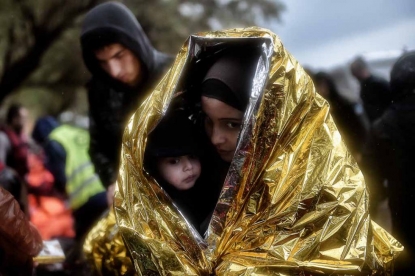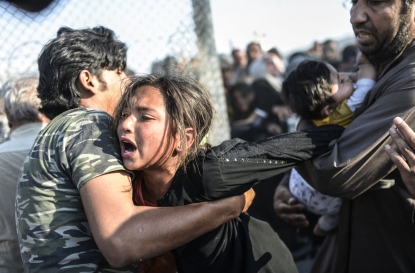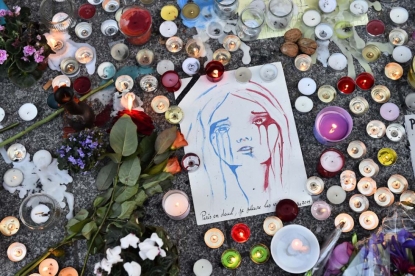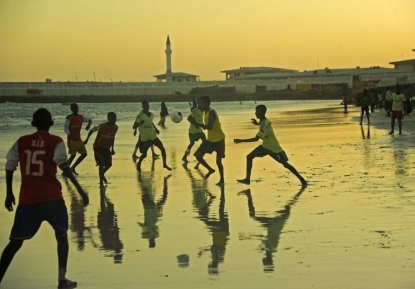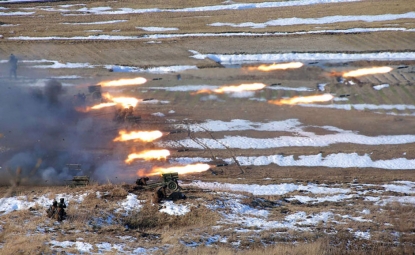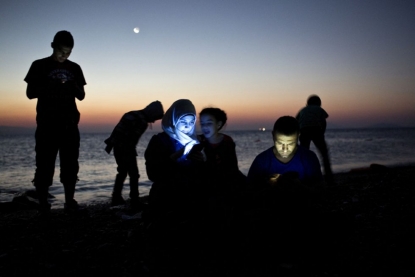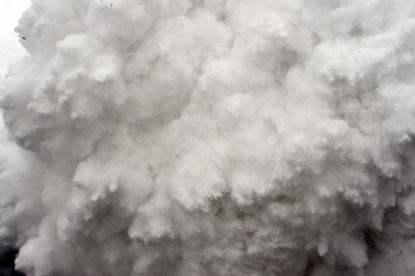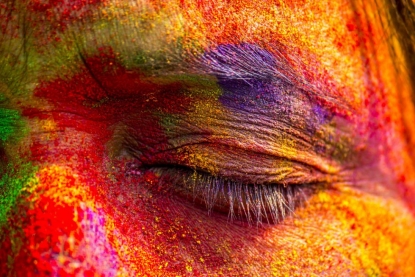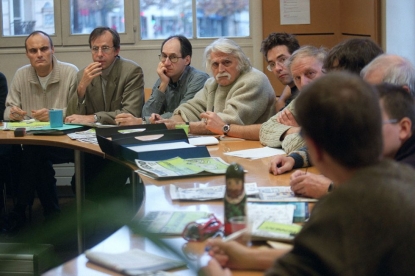The 15 most-read stories in 2015
These were the 15 most-read stories in 2015 on our AFP Correspondent blog. We wish all our readers a happy New Year.
1. War in peace, by Aris Messinis
(AFP Photo / Aris Messinis)
AFP's chief photographer in Greece Aris Messinis knows what a war looks like. He's covered conflicts in Syria and Libya. He has seen death and suffering. But covering the migrants arriving in their hundreds on the shores of the Greek island of Lesbos has affected him more.
"You constantly realize that you're not in a warzone. That you're working in a place where there is peace... the human pain is the same as in a war, but just knowing that you are not in a warzone makes it much more emotional. And much more painful."
Continue reading...
2. Fleeing through the eye of a needle, by Bulent Kilic
(AFP Photo / Bulent Kilic)
"We have been on the Turkey-Syria border for a week now, within sight of Tal Abyad where Kurdish forces are battling Islamic State jihadists for control," writes AFP's Bulent Kilic. "On Sunday, June 14, thousands of people fleeing the fighting suddenly appeared from behind the hill and swarmed down towards the border fence. Everything happened in five minutes. It was like a Hollywood film."
"I have been photographing this refugee crisis for nearly four years now, but yesterday was different. Almost every woman had children with her. I have never seen anything like it."
Continue reading...
3. Lives cut short
(AFP Photo / Loic Venance)
Their names were Bertrand, Chloe, Halima or Thierry. They were a student, a banker, a mechanic or a waiter. Most were in their 20s and 30s. All died in the Paris attacks of November 13 or in the days that followed from their injuries.
A small team of AFP journalists was put in place after the tragedy to try and collect at least a few personal details about each of the victims. The result is an interactive database, so that the death toll is not just a number, and so each victim has a face.
Continue reading...
4. From streets of fear in Mogadishu to "paradise in Paris", by Mohamed Abdiwahab
(AFP / Mohamed Abdiwahab)
"Are there any happy moments in Somalia?" AFP photographer in Mogadishu Mohamed Abdiwahab asks himself. "I can't say there have been any ever since I started this job. But sometimes I feel happy when there's a calm moment and I can photograph people relaxing at the beach or playing football… Those are real moments of joy for me."
"But I know that the next day, or even that afternoon, the violence and the chaos will return. So I can never be 100 percent happy."
Continue reading...
5. 'Those disguised as Arabs', by Andrea Bernardi
(AFP Photo / Abbas Momani)
"It's fairly common to see Israeli agents infiltrate the crowds of Palestinian stone throwers during demonstrations", writes Jerusalem-based video reporter Andrea Bernardi. "I've witnessed this plenty of times in Jerusalem. The goal of these 'moustaarinine' -- literally 'those who disguise themselves as Arabs' -- is to stop the protesters. They usually take out their weapons without using them, or, more often, point them into the sky, as if they were about to shoot into the air."
"But today I for the first time filmed these undercover agents firing live bullets into a crowd of protesters".
Continue reading...
6. From one nightmare to another, by Christophe Archambault
(AFP Photo / Christophe Archambault)
"We are here in the hope our pictures can put a human face on this crisis," writes the AFP photographer Christophe Archambault, who travelled to the Andaman Sea to find a boat carrying hundreds of migrants from the persecuted Rohingya minority, adrift off the Thai coast. "My first reaction is shock. Their faces are completely emaciated. You can see their ribcages, their pointed shoulder bones. We are witnessing a situation of absolute horror."
Continue reading...
7. Photography: telling art from fraud, by Roland de Courson
(KCNA Photo)
The above image was never distributed to AFP's clients. Issued by the North Korean agency KCNA in 2013, it purports to show military manoeuvres in the east of the country. But analysis of the missile fire and smoke, using specialist software, revealed a series of anomalies indicating it had been manipulated. It is, in all likelihood, a doctored image. This is an extreme case, but fraud in photography is far from limited to North Korea, Syria or extremist propaganda movements. On February 12, an unprecedented number of entrants were disqualified from the World Press Photo awards for tampering with their images - reviving an old debate about the fine line, in photojournalism, between artistry and fraud.
Continue reading...
8. The Fall, by Valeriano Di Domenico
(AFP Photo / Valeriano Di Domenico)
"When AFP calls at five pm on Tuesday evening, to ask me to cover a last-minute press conference at FIFA’s headquarters in Zurich, I have little idea I will be getting a front-row seat to football history," writes the photographer Valeriano Di Domenico. "When Sepp Blatter announces his resignation, I can’t believe my ears. But suddenly I realise none of the shots I have taken so far illustrates the magnitude of what is taking place. THE picture, the one that symbolises the fall of the boss of world football, will be the one of him leaving the room."
Continue reading...
9. 'The lucky ones', by Serene Assir
(AFP Photo / Angelos Tzortzinis)
"It’s 4:00 am, stars fill the velvet night sky and the Aegean Sea is perfectly still", writes AFP reporter Serene Assir. "A few journalists gather at the beach in Greece’s resort island Kos, waiting in silence on an unlikely frontline of Europe’s worst migration crisis since World War II. Today, like every other day, scores of refugees and migrants fleeing war and misery will reach the shore on inflatable boats, dreaming of a better life in Europe."
“Greece? Turkey? Where am I?” pants a man in his forties as he clambers out of the dinghy, tearing off his bright orange life vest. “You’re in Greece,” I reply. Overcome with emotion, he kneels down on the sand to pray, grateful that he has made it to Europe alive."
Continue reading...
10. The crying man, by Sakis Mitrolidis
(AFP Photo / Sakis Mitrolidis)
"Suddenly a man emerged from the bank yelling and gesturing, holding in his hand a savings book and his ID card," writes the AFP photographer Sakis Mitrolidis, who took the viral picture of a Greek pensioner weeping on the street. "Immediately I picked up my camera and started shooting. The poor man. After seconds he collapsed to the ground."
"Some people have suggested it is THE defining picture of the Greek crisis. I don’t see it that way. I think it tells part of the story."
Continue reading...
11. Whipped by the sharia police, by Nurdin Hasan
(AFP Photo / Chaideer Mayhuddin)
"It's not clear if the caning itself was responsible for the young woman collapsing, or the trauma of being punished so publicly before an enormous crowd," writes Nurdin Hasan, an AFP correspondent in Aceh, the only province in Indonesia allowed to implement Islamic sharia law, where public canings for "immoral acts" have been on the rise.
Continue reading...
12. I'm going to be buried alive, by Roberto Schmidt & Ammu Kannampilly
(AFP Photo /Roberto Schmidt)
Roberto Schmidt, AFP’s South Asia photo chief, and Kathmandu bureau chief Ammu Kannampilly had just reached Everest base camp on assignment on April 25 when an avalanche - triggered by the earthquake that has killed more than 5,000 in Nepal - thundered down the mountain leaving at least 18 people dead. This is the story of their near-fatal experience.
Continue reading...
13. Six months in India: my best-of video, by Agnes Bun
(AFP Photo)
"In February 2015 I moved to New Delhi to become AFP’s South Asia video coordinator", writes journalist Agnès Bun. "While I had travelled to the region before and did my homework after I got the job, I soon realized that I would have to expect the unexpected. All these moments, all these faces, do not always find their place in a news agency’s video output. That is why I wanted to gather them in a personal video, in a tribute to a unique and fascinating country that I have barely started to explore and which reminds me every minute that there are still so many brave, resigned or mischievious smiles left to be captured and shared."
Continue reading...
14. 'Little Schoolboy' at Charlie Hebdo, by Karim Talbi
(AFP Photo / Francois Guillot)
"Charlie Hebdo’s cartoonists were not my friends. They were my first family in journalism, the one you can never fall out with," AFP's Karim Talbi, who started his career at satirical weekly, writes in tribute to his friends, murdered by Islamic extremists. "I would never be where I am today without the good old Wolinski, Cabu, Charb and Tignous."


